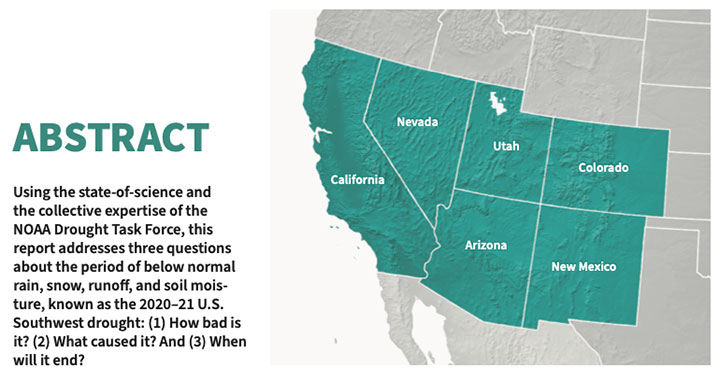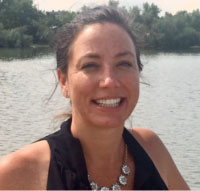On Friday, in Part One, I shared a few thoughts about a new report, just out from the National Oceanic and Atmospheric Administration (NOAA), which looked at the 2020-21 drought in the Southwestern U.S. The report, produced by 25 scientists and other experts, runs 20 pages, and addresses three critical questions about the drought. How bad is it? What caused it? When will it end?

You can download the report here.
From the report:
What is VPD?
Vapor pressure deficit, or VPD, is a quantity that combines temperature and humidity to indicate the atmospheric demand of moisture from the land surface (e.g., soils, streams, rivers, lakes, etc.). VPD is in units of hectopascals, or hPa, which is a measure of pressure (force per unit area). Here the value represents the difference in pressure exerted by water vapor in the ambient air versus the pressure water vapor would exert if the ambient air were saturated (i.e., if relative humidity brought to 100%). In other words, VPD is an indicator of the difference between how much water vapor the atmosphere is capable of holding and how much it actually holds at any given time. As temperature increases, atmospheric demand of water increases exponentially. As such, higher VPD means the atmosphere can extract more water from the surface, drying it out.
This, I believe, is a scientific way of saying that things dry out faster when it’s hot outside. Which would explain why the soil and vegetation dries out more during warm weather, and why reservoirs — like, for example, Lake Mead and Lake Powell — evaporate more water into the atmosphere, as the temperature rises.
Not only is less water flowing into the reservoir, but more is evaporating out of it. Add to that, the annoying fact that farmers and ranchers and golf courses, the folks who use about 90% of all the water used in the Southwest, use more of it when soil and vegetation are drier.
Perversely enough, at the very same time that less water is flowing into reservoirs like Lake Powell and Lake Mead, the demand for irrigation water is increasing. Maybe not ‘exponentially’, but increasing nevertheless.

We understand that reservoirs do not normally become depleted, unless people are drawing out more water than Mother Nature is putting in.
And Mother Nature has her own agenda, which is not necessarily our agenda.
Colorado water advocates want us to be concerned, and keep our eye on both quantities. The amount going in… and the amount going out.
The U.S. Bureau of Reclamation released a statement, on September 22, that things aren’t looking very hopeful. (The USBR is the agency that built Lake Powell and Lake Mead, way back when, when it seemed like a good idea.)
At Lake Powell, the projections indicate the potential of falling below minimum power pool as early as July 2022, should extremely dry hydrology continue into next year. Beyond 2022, the chance Lake Powell could fall below minimum power pool ranges from about 25% to 35%…
At Lake Mead, today’s projections indicate the chance of Lake Mead declining to elevation 1,025 feet (the third shortage trigger) is as high as 66% in 2025, and that there is a 22% chance of the reservoir elevation dropping to 1,000 feet the same year…
The phrase “minimum power pool” highlights the fact that USBR pays for the operations of the Glen Canyon Dam (Lake Powell) and the Hoover Dam (Lake Mead) by generating hydroelectricity. So this isn’t only about water.
And the people who oversee our water situation here in Colorado understand very well that it isn’t only about water.

Below is a statement from Colorado River Commissioner Rebecca Mitchell, shared last Wednesday via an email newsletter. She mentions the “Upper Basin” of the Colorado River, which includes about half of Colorado and Utah, a third of Wyoming, and a corner of New Mexico and Arizona. Ms. Mitchell, known to her friends as Becky, also heads up the Colorado Water Conservation Board. She has worked in the public and private sector as a consulting engineer; she received both her B.S. and M.S. from the Colorado School of Mines.

Though deeply troubling, these projections tell us what we already know and have experienced in Colorado and the whole Upper Basin – that this has been a very dry and challenging year and these conditions will continue into the future. Our water users have already experienced painful and deep cuts, and these will continue. Colorado is fully committed to working with the basin states and the Bureau of Reclamation to chart a course that provides additional security to the entire Colorado River Basin and its water users during this challenging time and into the future.
Ms. Mitchell knows much more about Colorado’s water than I ever will. But she isn’t in complete agreement with the 25 scientists and experts who wrote the NOAA Drought Task Force Report. Ms. Mitchell tells us that drought conditions will continue into the future. Not that they might continue into the future, but that they will continue into the future.
Indefinitely, into the future? She doesn’t say. But explicitly, “into the future”.
For all we know, she might be right. Time will tell. Predictions either come true, or they don’t.
The 25 NOAA scientists and experts have taken a slightly different approach to the problem. They wrote:
Taken together, even if higher annual precipitation totals occur in coming years, it will take several seasons (and potentially years) of above-average precipitation to replenish the reservoirs, rivers, streams, and soil moisture that 60+ million people depend on for their water, livelihoods, food, power, and recreation. This, when coupled with the La Niña forecast for the coming winter, suggests the ongoing Southwestern U.S. drought will very likely last well into 2022, and potentially beyond…
The scientists are using terms like “very likely” and “potentially”. They understand that we cannot accurately predict the weather more than a few days in advance. And sometimes, not even then.
Like, when I checked the weather prediction on Thursday afternoon, it was supposed to rain on Friday. But it didn’t. No thunderstorm either.

With all of this in mind, we might want to pay some attention to what’s happening locally, right here in Archuleta County.
Various people have various ideas about how to get the most benefit out of the San Juan River…
